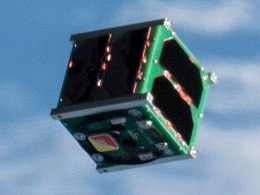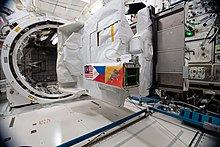BHUTAN-1
 | |
| Mission type | Technology demonstration |
|---|---|
| COSPAR ID | 1998-067PF |
| SATCAT no. | 43591 |
| Website | birds2 |
| Spacecraft properties | |
| BOL mass | 1.11 kg (2.4 lb) |
| Dimensions | 10 × 10 × 11.35 cm |
| Start of mission | |
| Launch date | 09:42, June 29, 2018 (UTC) |
| Rocket | Falcon 9 Full Thrust |
| Launch site | Cape Canaveral SLC-40 |
| Contractor | SpaceX |
| Deployed from | ISS |
| Deployment date | August 2018 |
| Orbital parameters | |
| Regime | Low Earth |
| Periapsis altitude | 355 km (221 mi)[1] |
| Apoapsis altitude | 362 km (225 mi)[1] |
| Inclination | 51.6°[1] |
BHUTAN-1 was the first Bhutanese satellite to be launched into space. The satellite was built during Kyushu Institute of Technology's Birds-2 program. The Birds program helps countries fly their first satellite. BHUTAN-1 was launched into orbit aboard the SpaceX CRS-15 mission on June 29, 2018. It was deployed from the Kibo module of the International Space Station (ISS) on August 10, 2018.
The satellite has cameras to image the Earth.
Background
The Kyushu Institute of Technology (Kyutech) in Japan supports non-spacefaring countries to build their first satellite through a program called The Joint Global Multi-Nation Birds Satellite project (BIRDS). Five countries participated in the first Birds program.[2][3]
In 2016, Bhutanese Prime Minister Tshering Tobgay mentioned plans to set up a space agency with Bhutan's Information and Communications Ministry. According to Tobgay, plans to launch the first Bhutanese satellite to space came from Bhutanese King Jigme Khesar Namgyel Wangchuck.[4]
Three satellites were developed during the Birds-2 program: BHUTAN-1 (Bhutan), UiTMSAT-1 (Malaysia) and Maya-1 (the Philippines). BHUTAN-1 was designed by Bhutanese graduate students who were pursuing their master's degree at Kyutech.[5] The satellite was developed under the Kyutech-led second Joint Global Multination Birds Project (Birds-2).[6]
Development
The Birds-2 project commenced in November 2016.[4] BHUTAN-1 is classified as a 1U CubeSat[5] and measures 10×10×11.35 cm and weighs 1.11 kg (2.4 lb).[7] The satellite was developed and designed by a team of four Bhutanese engineers. The satellite is part of their master's degree in space engineering at Kyutech.[8]
The designing and testing of BHUTAN-1 began by March 2017. The functions of each sub-system of the satellite was verified before the first engineering model of BHUTAN-1 was built in June of the same year. By October 2017, the second engineering model was completed and the development of the flight module commenced.[4]
Mission
Launch

BHUTAN-1 was launched to space on June 29, 2018, via the Falcon 9 Full Thrust rocket at Cape Canaveral in Florida,[5] as part of the SpaceX CRS-15 Commercial Resupply Service mission. Maya-1 and UiTMSAT-1 which were also developed under the Birds-2 project was also among the payload of the rocket.[9] BHUTAN-1 was deployed from Kibo Module of the International Space Station in August 2018, becoming the first Bhutanese satellite.[10]
Operations
The satellite operates at an altitude of 500 to 1,500 kilometres (310 to 930 mi) and passes over Bhutan for three to four minutes four to five times per day. Its designed lifespan is six to nine months, though reportedly it can last up to two years. BHUTAN-1's two cameras capture satellite imagery of Bhutan to help assess the country's glaciers, lakes, and forest cover. It also provides basic communication services and is used to study radiation effects on satellites.[5] While BHUTAN-1 was built solely by the Bhutanese, the satellite is jointly controlled and operated by the Bhutan, Malaysia, and the Philippines.[6]
BHUTAN-1 is tracked from the ground station operated by Bhutan's Information and Communications Ministry.[5]
References
- ^ a b c "BHUTAN-1 – Satellite Information". Heavens Above. Retrieved February 22, 2020.
- ^ "Bird B, BTN, G, J, M, MYS, N, PHL (BRAC Onnesha, GhanaSat 1, Toki, Mazaalai, Nigeria EduSat 1)". Gunter's Space Page. Archived from the original on June 30, 2017. Retrieved July 24, 2017.
- ^ Francisco, Mikael Angelo (1 July 2018). "Space To Excel: Why The First Pinoy-Made Cube Satellite Matters". FlipScience. Retrieved 4 July 2018.
- ^ a b c "BHUTAN-1 expected to be in space by May". Kuensel. 1 February 2018. Retrieved 4 July 2018.
- ^ a b c d e Palden, Tshering (30 June 2018). "BHUTAN-1 leaves for space". Kuensel. Retrieved 4 July 2018.
- ^ a b "Maya-1: Cube satellite latest Pinoy venture into space". Philippine Daily Inquirer. 1 July 2018. Retrieved 4 July 2018.
- ^ "Joint Global Multi Nation BIRDS 2(BIRDS 2 Satellite Project)」 衛星の完成について" [Joint Global Multi Nation BIRDS 2 (BIRDS 2 Satellite Project): The Completion of the Satellites] (PDF) (in Japanese). Kyushu Institute of Technology. 26 February 2018. Retrieved 4 July 2018.
- ^ Seldon, Perma (30 June 2018). "Bhutan launches its first satellite into space". The Bhutanese. Retrieved 4 July 2018.
- ^ Panela, Shaira (29 June 2018). "Philippines launches 1st CubeSat into space". Rappler. Retrieved 4 July 2018.
- ^ "Three CubeSats successfully deployed from "Kibo" as part of BIRDS Project!". JAXA. August 17, 2018. Retrieved February 17, 2020.
